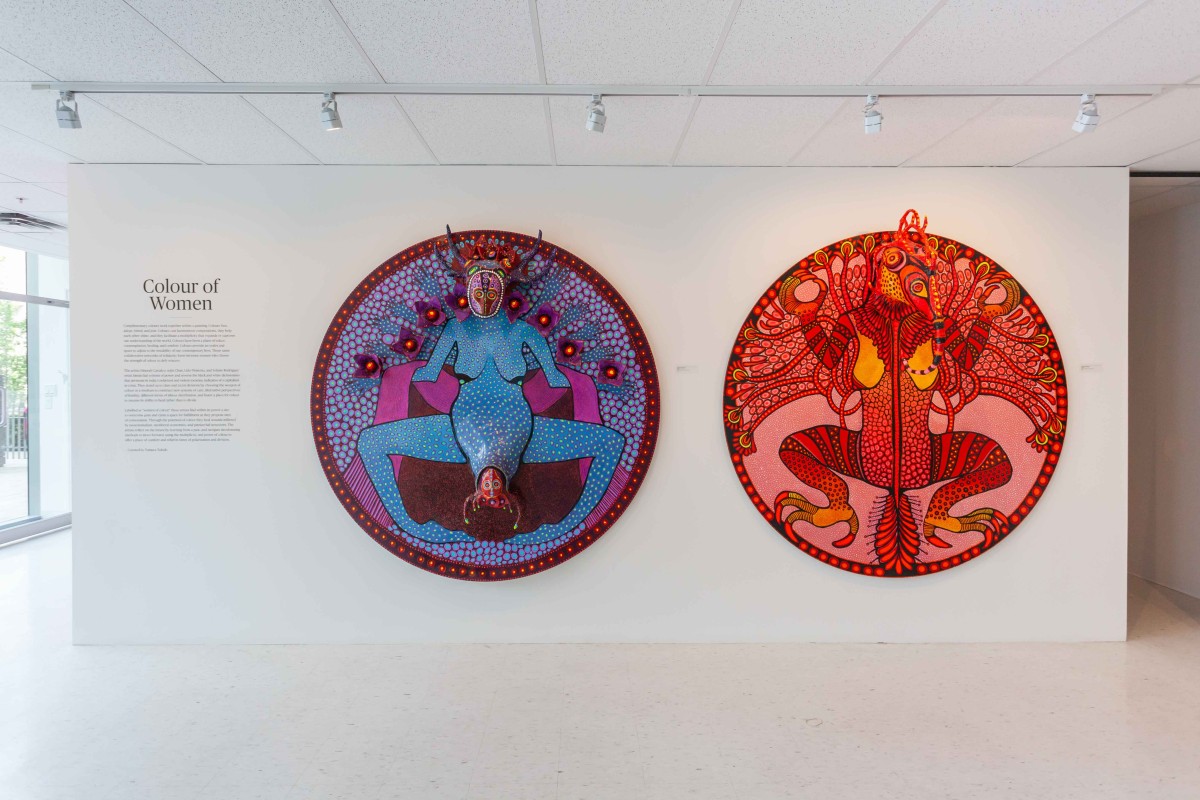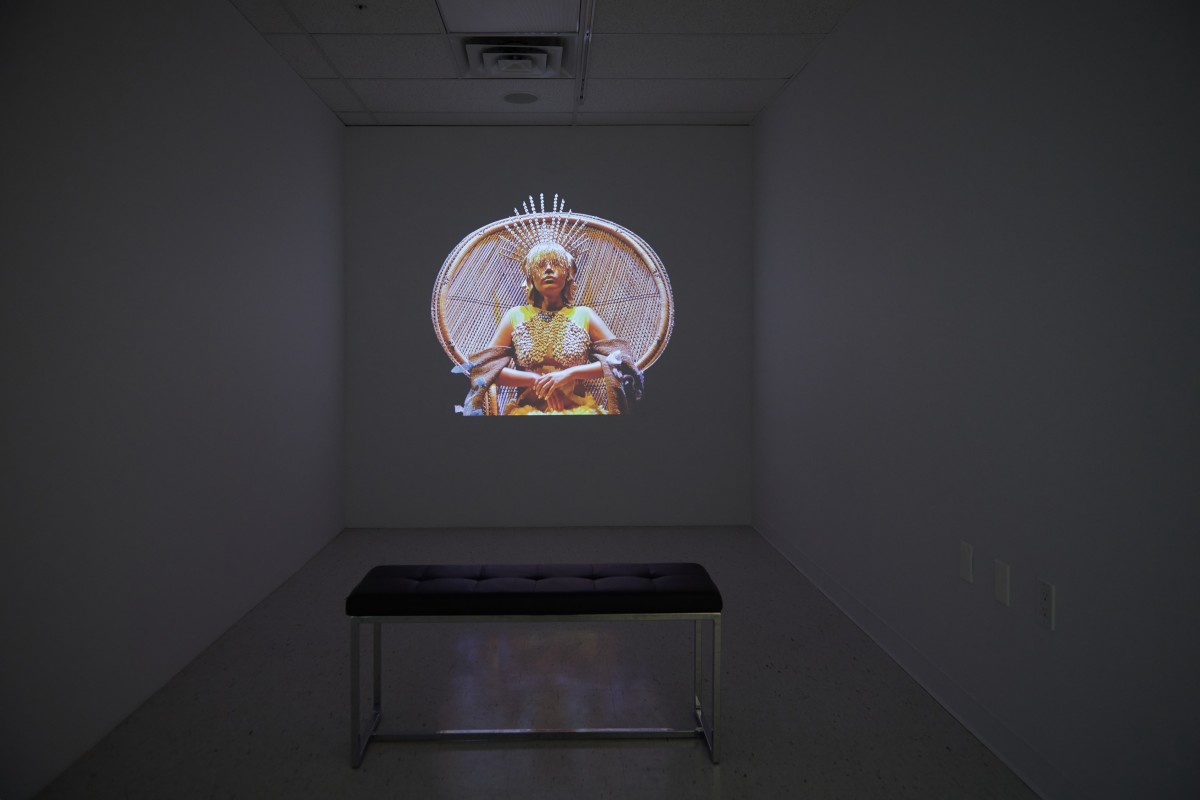Colour of Women
Curator Tamara Toledo of Sur Gallery tells us about her newest exhibition, Colour of Women, showcasing four women artists whose work highlights the different ways colour can be used as a point of resistance.

Photo credit Claudia Arana
In Sur Gallery’s newest exhibition, Colour of Women, four women artists come together to showcase through their work the ways colour can be used to resist hierarchal systems of power, class and racial division. Featuring works by Dinorah Catzalco, soJin Chun, Lido Pimienta and Yelaine Rodriguez, Sur Gallery is Toronto's first gallery space dedicated to celebrating and promoting contemporary Latin American and Latinx art. This exhibition, on view now through July 9, is curated by Tamara Toledo, a Chilean-born, Toronto-based curator, scholar and artist. For more than a decade, she has played a strong role in uplifting and promoting Latinx artists in Canada.
Adam Harris Levine, the curator of Faith and Fortune: Art Across the Global Spanish Empire and AGO Assistant Curator, European Art, caught up with Toledo to chat about Colour of Women and her curatorial views on Latinx art.
Levine: Can you tell us a bit about Sur Gallery and its history? How does it fit more broadly into the ecosystem of Latinx artmaking in Toronto and Ontario?
Toledo: Sur Gallery is one of LACAP’s projects, which is the umbrella organization that began in 2003 with the implementation of art and advocacy initiatives in Toronto. Initially, we organized a multidisciplinary arts festival, the Allende Arts Festival, for nine consecutive years. This was a festival that presented socially and politically engaged work. We also led educational and advocacy projects to support our community. At the time, there were very few spaces and platforms for BIPOC folks, mostly token opportunities for just a handful of people. It was especially limiting for those who affiliated themselves with social justice and activist ideological frameworks, which we all undertook in our work and lives. Our work was too political, too figurative, too narrative, too locally based and too personal.
From the beginning, we always intended to open a space of our own, where we could program, articulate, theorize, explore and create on our own terms, but it proved to be very difficult. It wasn’t until the Pan American/Parapan Am Games came to Toronto that we were able to leverage this opportunity and find the resources and financial support to open an art space dedicated to contemporary Latin American and Latinx art. We built both LACAP and Sur Gallery from the ground up, at a time when very few had any interest in this particular diaspora. In fact, I believe it was the Latin American Speakers Series led by LACAP that opened avenues of appreciation and interest in art from Latin America from mainstream art circuits in Toronto. Through the series, we were able to bring renowned artists and curators, such as Gerardo Mosquera, Alfredo Jaar, Tania Bruguera, Regina José Galindo and countless others. Many in Canada may know these names today, but back then, Canadians were just beginning to learn about their relevance within the international art scene. Very few institutions had at that point shown work by prominent artists from Latin America, but today, we are able to see Félix González Torres at MOCA and Paulo Nazareth at The Power Plant.
Levine: Your current exhibition, Colour of Women, brings together the works of four artists that engage with colour as a tool for seeing our world in new and radical ways. How did you choose these artists? Do they know each other? Have any of them ever shown together before?
Toledo: They do see the world in new radical ways, and they share this vision with us through the potential of colour. They are not afraid of using colour and they are inspired by ancestral lineage, generations of women who come before them. The artists did not know each other prior to the exhibition; Sojin Chun knew of Lido Pimienta as a singer/composer, but not as a visual artist. This to me is all the more fulfilling, because I am able to create those bonds and facilitate a link between artists, expand their networks, grow and develop their careers. I feel privileged to be able to curate at Sur Gallery, but I also always feel limited by the size of the gallery space. I’m saying this because there are so many other women I would have loved to invite to this exhibition, but due to resources and space limitations, I had to refrain.
I tend to curate exhibitions that are interdisciplinary and find intersectional artists that develop practices aligning with the theme I want to explore. For Colour of Women, it was not only about colour in a literal sense, but my intention was also to invert the phrase “women of colour” so often used to describe and label us, and offer a spin on what this definition could mean, i.e. reversing systems of power, disrupting polarized dichotomies and instead constructing new systems of care, alternative perspectives, and fostering the ability of colour to heal rather than to divide.
Levine: Has working on this exhibition changed the way you think about or relate to colour?
Toledo: Perhaps a little. As do many of the exhibitions I curate, this one, in particular, had a personal interest to fulfill. I am a trained painter and started my professional career in the late 1990s as a visual artist. My work at the time was considered too colourful, too narrative, so I had a very difficult time finding spaces to disseminate my own work. That is partially why I began advocacy projects through LACAP, even though I did not use these to necessarily showcase my own work for conflict of interest. I haven’t painted in over a decade but find it inspiring and powerful to see women today engage with colour so freely, with such strength and conviction, with no fear of being judged or pigeonholed. It makes me want to paint again.
Levine: When I visited the exhibition, I really loved how each artist was given their own zone in the space to build their own immersive world. What is important to you when you’re installing different artists’ works in a group exhibition like this one?
Toledo: Even though the gallery is small, I have designed the white cube to create those “different zones” and leave room for each artist to shine both on their own and as a group. As you have seen, the correlating theme is the power of colour, but all the artists explore the concept in completely different ways. For example, Sojin Chun invents the word tealquoise and uses this in-between colour to question capitalism, labour distribution and relationships. Yelaine Rodriguez uses colour as a space of commemoration, spirituality and Afro-resiliency. The fact they all explore the theme in different forms and disciplines also separates them from each other. Latinx artists are very diverse, ethnically, culturally, racially, politically, etc. Sojin is a Korean immigrant who was raised in Bolivia and is now based in Toronto, and Yelaine was born in the Bronx of Afro-Dominican background. They have little in common, and this difference is celebrated and acknowledged. Not only thematically, but spatially within the gallery space. I design the space in tandem while attempting to establish a conversation between the artworks.
Levine: An exhibition can be very different in the planning stages versus when you install it in the gallery space. Did you learn or discover anything exciting when the works were brought together at Sur Gallery?
Toledo: Yes! I was surprised by Dinorah Catzalco’s work. I had only seen documentation of her circular paintings, and although I was aware of their sizes, I had not been able to imagine the scope of their presence. I was surprised by the size and three-dimensionality of the work. They are quite impressive when you see them in person and documentation does not do them justice. I had hoped to have shown the complete series, but I had to choose only four of a selection of 25 72-inch circular paintings. It was an extremely difficult task, they are all overwhelmingly beautiful, striking, full of meaning and content.
Levine: In addition to your roles as director and curator at Sur Gallery, you are also working on your PhD at York University. Can you tell us about your research there?
Toledo: My professional career as a curator connects with my scholarly pursuits. In essence, what I have done is to continue to find avenues of representation for Latinx artists, but with the back-up of an academic institution. I have been involved in the arts for over twenty years and started from the ground up, building resources, providing infrastructure and developing opportunities where initially there were none for my diaspora in Toronto. Since childhood, I have been formed and nourished by anti-imperialist and solidarity ideologies, and was formed as a politicized subject, with a vision to contribute collectively to the betterment of society. Therefore, my professional career is intrinsically linked to those aspirations and ideologies, and I have followed a path of advocacy within my artwork, with the curatorial projects I develop, and today with the scholarship I engage with.
As a PhD candidate in Art History and Visual Culture, I try to juggle my two pursuits by embracing their connections. I aim to disrupt who gets to be written about within art history. As a scholar, I continue to address the need for change, but my main objective is not only to create platforms to present work by a diaspora but to critically examine and write about them, within the field that has opted to exclude them. I decided to return to academia after many years of working within the art industry because I felt the pressing need to address the lack of representation of Latinx Canadian art within a critical analysis, scholarly research, and frameworks of study. To a certain extent I’ve been able to fulfill this urgency through my curatorial and advocacy work, but I have found that within a system that excludes, it is a battle just to be recognized, heard or even acknowledged, and I thought that the best way would be to insert myself in academia and write, archive and position our own stories with the validation it deserves.
Levine: What future exhibitions can we look forward to at Sur?
Toledo: Our fall exhibition, entitled People United, will depict how today we embrace the strength found within each other, the demand for a different outcome, a transformed worldview, removed from colonial and imperial legacies that perpetuate a state of coloniality. The exhibition will capture moments in time of resurgence, contestation and emancipation– with artists from the Beehive Collective and LASTESIS collective, as well as artists Carlos Colín, Cristián Ordoñez and Syrus Marcus Ware.
Our winter 2023 exhibition is a partnership with Agnes Etherington Art Centre and the Textile Museum of Canada. Curated by Nathalia Santos Ocasio, the exhibition Hilos Conductores/Common Threads explores the entanglement between Chile with Canadian extractivism, through the medium of arpilleras.
For more information on Colour of Women, participating artists and upcoming exhibitions at Sur Gallery, visit https://www.surgalleryvirtual.ca/colour-of-women.


